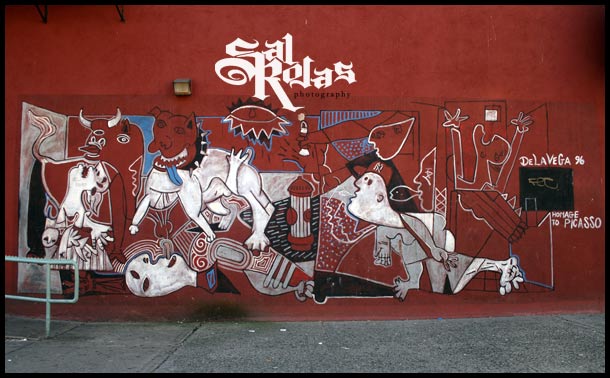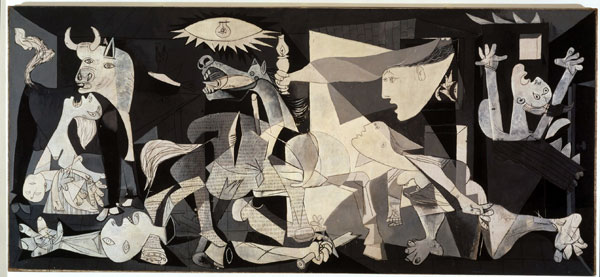|
| |
Homage to Pablo Picasso by James de la Vega | Spanish Harlem
Homage to Pablo Picasso by James de la Vega | Spanish Harlem

In James De la Vega's Gotham version of "Guernica," the figures agonizing under a rain of bombs are, instead, victims of poverty, oppression and drugs. The bulls of Picasso's masterpiece become snarling pit bulls.
HOMAGE TO PICASSO.1996
Spanish Harlem, New York City
Subliminal imagery painted on the minds of unsuspecting observers remains imprinted on the conscience, long after they pass the brick wall on canvas of a street life artist. Different shades of trauma send chills down the spine of the beholder as lines of pain define themselves upon varying tones of horror. The very hues of color give depth to a picture invoking realness in an abstract world... where the laws of proportion have been distorted.
To know the inspiration came from within the tormented spirit of another person, is to understand his therapy is relaying a message to the public in expressive form. Not doing so would require him to accept silence and his opinion would go unnoticed. So his imagination releases his hatred of injustice and a statement is made without words. Oh, how the artist suffers for his art; and yet, the world admires his agony.
Palabras: BrownPride.com's Gato
Homage to Picasso Photograph by:BrownPride.com's Sal Rojas (October.2006)
For more info on James de la Vega Click Here

GUERNICA.1937
Oil on Canvas
Museo Reina Sofia, Madrid, Spain
"Painting is not done to decorate apartments. It is an instrument of war for attack and defense against the enemy." � Pablo Picasso 1945
Pablo Picasso�s GUERNICA
The most famous single work of the 20th century, this Civil War protest painting was commissioned by the Spanish Republican government in 1937 for a Paris exhibition. The artist found his inspiration in the mass air attack of the same year (April 26, 1937, a busy market day) on the Basque town Guernika-Lumo (Guernica), Guernica was the target of the world�s first saturation bombing raid, carried out by Nazi aircraft at the request of General Franco. The air raid destroyed the city, killing an estimated 1,600 Basque people and injuring many more. The painting hung in a New York City gallery until 1981, reflecting Picasso�s wish that it should not return to Spain until democracy was reestablished. It was moved to Centro de Arte Reina Sofia in Madrid, Spain from the Museo Prado in 1992.
|
|
|
|




